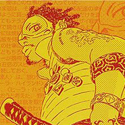|
Star Trek (and Star Wars) had that Decipher problem where even more than other games it felt like if you took the slightest step out of the casual scene you needed a deck almost entirely of rares, especially when you got into the different side decks with their magic bullets. (If the magic bullet cards were common, then disregard that save it was still really annoying to play with.)
|
|
|
|

|
| # ? May 18, 2024 14:01 |
|
hyphz posted:Are we allowed to include dead digital CCGs on this? Or recent ones that stillbirthed? I remember the Heroes of Might and Magic digital CCG being fantastic, I did the thing I do with CCGs where I was super into it, then lost some interest, then eventually came back, but when I came back the writing was on the wall and the game was about done. Except unlike my normal CCGs, I no longer have a box of cards in the basement I can look at with nostalgia.
|
|
|
|
Force of Will, or "Hey, you got anime in my Magic the Gathering" Force of Will is Magic the Gathering but with better mechanics but suffered from worse powercreep. Thank you for coming to my Ted Talk. ... Oh, you actually want me to put effort into my effortposts. Fair enough. Force of Will is a Japanese card game that came out in 2012, and made its way overseas in 2013. It's not technically dead, but from what I gather the pandemic ended a lot of local support for it. It draws HEAVILY from real-world myths and stories, along with the occasional "Special Edition" fixed box set that will crossover with, say, Valkyria Chronicles or Ghost in the Shell. Did you want to have Cain vs Abel? The Moon Princess Kaguya using orbital defense satellites against Nyarlathotep? Alice vs an alternate universe Alice where she was corrupeted by a dimension-shifting evil cat called Schrodinger? You can! Basic Mechanics You and your opponent start with 4000 life, and you hit the opponent until their life is 0. You have 2 decks, one a deck of 40 to 60 cards, and a seperate deck for Magic Stones, the land of the game. You also have a Ruler, similar to Magic's Commanders. There are 4 types of cards, resonators (creatures), chants (spells), additions (enchantments) and regalia (artifacts/equipment). Cards fall into 5 colors, Yellow (Light), Red (Fire), Blue (Water), Green (Wind) and Purple (Darkness). Colorless cards are considered Void type. There is technically a 6th color of card for "Moon", but it only shows up on a handful of cards. If a lot of the attack, defence and life numbers seem like "Magic numbers but times 200"... yeah, that's the rule of thumb I tended to use when I tried to gauge how good a card was.   This is a Ruler and their J-Ruler side. Some Rulers have passive abilities, some can become creatures in their own right and enter play as J-Rulers, and all Rulers and J-Rulers have an unprinted rule that they can be tapped to put the top card of your Magic Stone deck into play. In this example, Moon Princess just has one ability, and that's to turn her into a creature and start throwing punches. Kaguya has some "Keyword" abilities in Flying and Imperishable (Flying works the way it does in Magic, and Imperishable means that if she's killed, she returns to the Ruler spot without losing her text box. Normally a killed J-Ruler is jus treated as a blank Ruler so you can still play Magic Stones) and specific keywords for when she enters play, a passive on-going ability, and an activated ability. One thing I'll give Force of Will over most card games, they clearly mark when each ability goes off. The numbers at the bottom are her Attack and Defence, and those work just like they do in Magic, and the icon at the bottom right corner shows what color the card is.  Resonators are basically the same as J-Rulers, with the only major difference being the cost in the upper-left corner. Each colored dot is a resource of the specific color, and the number can be paid by any color resource.  Regalia are Force of Will's Artifacts, they usually give strong buffs to your Ruler, and even more buffs if you're running the Ruler the Regalia "belongs" to. Some also give you alternate win conditions.  Chants are your Sorceries and Instants. Fairly straightforward.  Additions are your Enchantments. You play the Addition, if it's a Field spell it just goes onto the board, otherwise you attach it to the specified kind of card. Conclusion And that's Force of Will in a nutshell. So it's like Magic but with some better core mechanics, so what went wrong? Personally, there were 3 major things. 1) The game originally drew heavily from real-world stories and mythes, but by the third cycle, was doing a lot more internal world building and only drawing a bit from real world stories, but also making Alice (From Alice in Wonderland) not only a central character, but literally the most important character in the plot. So if you were drawn to the game because of the mythes and fables battle-royale concept, you had a year+ where it was 99% "OC characters, do not steal". The librarian that wanted to burn down the entire timeline was pretty cool though. 2) Wizards of the Coast know that cards that show up in 90% of decks are meta-warping and should probably be banned for the health of the game.   Reflect/Refrain was a card that was so good of a toolbox card and accelerated decks so much that you either were running Reflect/Refrain as your Ruler, or you were losing. Remember that thing I said about "Killing a J-Ruler made it effectively a blank Ruler"? Refrain had no stats, so she couldn't be killed with spells that dealt damage or attacked, and if you did try to hit her with a spell that killed J-Rulers, she could either cancel the spell or just flip back into Reflect for free anyways. Reflect/Refrain was eventually banned after almost a full year of warping the meta, but the damage had been done. I know a few people who quit the game because R/R was just that unfun to play against. 3) Simply put, the game had a habit of introducing new creature types or mechanics but only give them support in that specific set. Just as an example, this is Cain (Yes, THAT Cain. His brother is in the game too, along with a card depicting the first murder. His Ruler side just has "Awakening: R" so you're not missing much):  He buffs Cognates. How many Cognates are there?    Eeeeeyup, that's literally it for Cognates. They were all from the set Cain came in. And this isn't a new set, Cain is from the second (first in NA, I think) cycle of sets. I'm pretty sure there was even a card that had Jesus on it, but the Force of Will wiki seemed to go down while I was working on this post, so if I can find it later, I'll post it in the thread, but instead, have a picture of the card showing the first murder! 
|
|
|
|
And now for On The Edge: Cut-Up Project pictures. Apologies if any of these are sideways, my phone and imgur can't seem to agree which way is "up" on images sometimes. First up, I like how there are several alternate-win cards, that take some rather... unusual ways about it     Next up is the "Randomly entertaining" cards     Five versions of the "same" character      Not sure if racist or just bad art            And finally, some cards where the art wouldn't be out of place in modern day political cartoons  
|
|
|
|
The Paralytic Banana was an actual weapon made up by ďa munchkin playerĒ in the original Over The Edge campaign. The munchkin player later admitted who he was: Greg Stolze. C.A.Radford is one person with a chaos infection. The RPG tells you to reroll their stats every time the PCs meet them. This is a huge pain in the rear end. The Pythagorean Convulsion art is a reference to the card ďZipperĒ from the core set, who has the highest collectors number in the game, and thus becomes Godzilla if affected by it. hyphz fucked around with this message at 17:27 on Aug 6, 2022 |
|
|
|
The Force of Will title reminds me of the anime CCG that I believe was licensed by Pioneer maybe that had a bunch of random anime characters in it. Ani-Mayhem it was called. I remember buying a box of cards for cheap but never found instructions for it.
|
|
|
|
So, when I asked about dead digital CCGs I really had one particular one in mind, because it's a death that I really felt quite sad about.  Prismata isn't quite dead. It isn't completely dead and buried and unplayable like some of the other early digital ones like Star Chamber and Free Realms (and I'm sure I remember an even older cyberpunk themed one but I can't remember the name). You can still download it. You can still buy the single-player content, and the multiplayer servers are up, just good luck finding a game. (The authors basically put it in the same category as the original Guild Wars - "we need the AWS instance, and Prismata adds so little to the cost there's no reason to take it down.") Why was I sad? Because this is an indie game, and it's a big effort indie game. First Kickstarted in 2014, it remained available and in development for 4 years before going F2P and for at least some time after that. (Ironically, it is still listed as "Early Access" on Steam.) And it has: (deep breath) a Story Mode with 3 complete episodes (there were supposed to be 5 but it died before the last 2 were written); casual, ranked, and friends online; streaming integration; vs AI with 8 different opponents; a quick tutorial; a game analysis tool; integrated online replay management; 50 training scenarios, and 34 puzzle challenges! There were going to be more of all of these, but when the player base cratered the authors more or less halted development saying they no longer enjoyed it. They didn't say why, but I'm guessing that pouring their work into the void got too demoralizing. So, the basic idea of Prismata: what if there was a CCG with no randomness? You build your deck, but then just choose cards from it rather than drawing at random. Even the acquisition of cards is done by levelling up and gaining "power cores" rather than buying random boosters. There are microtransactions, but they're for reskinning cards for multiplayer. Here's the start of a game:  Objective: wreck all the opponent's stuff. That on the left is your entire deck. You can see that there's five different resources, listed at the bottom of the screen. Gold and Gaussite (green crystals) are cumulative over turns if unspent. Behemium (blue metal), Replicase (red liquid) and Energy are not cumulative. We start with six drones, which produce gold, and two Engineers, which produce Energy. A glance over the deck will show why this is important - Energy is used to build drones. Each drone gives us one gold, and each Engineer gives us the opportunity to build one drone per turn. Engineers automatically produce their energy; Drones produce it only when clicked. Clicking a unit makes its shield icon disappear, and triggers it to use an ability that can only be used once per turn, but definitely does not tap it because that would require a patent royalty. So, we build up drones and engineers for a bit. You'll notice that most of the attacking units require some of the other resources to build. That's what the Conduit, Blastforge and Animus are for. Each one produces a Gaussite, Behemium, or 2 Replicase each turn for free. Once we have these out, we can start building up our attackers. Most units have "summoning sickness" in the usual way, but some take even longer to build. For example, this fellow, who is one of the most basic attack units:  You might notice something missing. There's no flavor text on any Prismata card. That's because the flavor was supposed to come through the story mode, and while that does give some idea of a setting, it doesn't necessarily delve into any unit. I don't recall ever actually being told what a Tarsier actually is (I'll save you a Google, it's the smallest extant species of primate). Combat is simple, but it's also brutal. Attack points are represented by swords, so the Tarsier there will give us 1 free at the start of each turn. Each unit has either a defense or a health score - the vast majority have defense. That represents how much damage it can soak up. Defense works like Toughness in Magic; a unit can take up to that number of points of damage and is totally unbothered by any less. Health, however, is cumulative - it's eroded by incremental damage. Units that At the end of a player's turn, their attack points are added up and compared to the enemy's total defense points. The attack is always made against the defender's entire card layout; there's no concept of a life total for the player - when you lose all your cards, you lose the game. If the defense points are greater, the defender assigns where the damage goes, which means they'll take it on blockers and other planned units; if the attack points are greater, the attacker assigns where the damage goes, which typically means they will either trash key points in defense or destroy resource generation. And.. well, that's pretty much it. Everything else is on the cards, and there's a large number of options. You've probably already noticed that there are mechanics in Prismata, like having both non-cumulative and cumulative health and resources, which would be a right pain to do physically but are nice and easy when a computer does them for us. And this is a good thing for a digital CCG - it takes advantage of the platform while at the same time still having the feel and play attitudes of an in-person game. So why did it die? Part of it, of course, was just timing. Name a digital CCG now and someone will say Magic Arena, Legends of Runeterra, Hearthstone or maybe Gwent - all big-money spinoffs of big-name existing IPs. It was always going to have trouble standing up to those and their marketing chops. But a bigger factor is just how it feels in play. Prismata is stressful. You know how in Magic, if the opponent gets an attacker out early, you just take the 1 life damage and figure that you've still got 19 or so to go? In Prismata, if that happens, there's no life total to save you. You're losing a unit. If you don't have a defender out, that probably means you're losing a drone. That's one less gold a turn. You can build another Drone, but the attacker will be back next turn. Hopefully, you'll be clueful enough to play a Wall, but walls are expensive for their defense points so can only act as a temporary measure; and if you're building walls, you're not gaining attack, so the opponent can build more offensive units. It can feel like at any given moment, you're only a single mis-play away from ending up in a resource-loss death spiral and feeding defensive units into a meat grinder. Losing Prismata hurts more than any CCG I know. It doesn't help, of course, that since there's no randomness it's an online pure-skill game, and those are usually doomed to Pareto death. As I mentioned, it's very unlikely you'll find an online game at this point, but if you do, you're going to get absolutely trounced. They're not all assholes, of course; plenty of people are around who'll teach. But there's a lot of learning to do, and the prize is just to be able to win at a game that maybe 50 or so people care about, so is it really worth it? So, there's Prismata. If you're up for a challenge and big resource management, you can grab it for free on Steam (you have to pay to unlock the later single-player content, though). But sadly, for most players it ends up in the box with games like Lawbreakers and Deadly Rooms of Death that want to be hardcore but can't back it up with actual community reward. The authors moved on to write a puzzle game with the unfortunate name of Jelly is Sticky (it's actually a decent game), and are apparently working on an open-world online game at this point.
|
|
|
|
That's rad. I've never heard of Prismata prior to now. It does seem to suffer from that problem common to a ton of CCGs: a runaway leader. So many of these games are about getting ahead early and just letting the game's mechanics suffocate the opponent with what little momentum you started with. Prismata suffers from this due to what you lose when you are attacked. Highlander suffers from this due to your hand size being tied to your life total. Magi Nation suffers from this in terms of simple arithmetic (more on that when I finish my effortpost about that). All of these games seem to have very few ways for a player to strike back or catch up once they've fallen behind even a little bit. That's something I've always valued about VTES: you can almost always bounce back. You can turtle-up and bide your time and wait or negotiate for your predator's predator to bail you out. Or you can find an opening yourself and oust your prey in a snap if they get overextended. There's lots of cases where all of your minions get dunked into torpor and you're just hosed, but there's many times more cases of salvageable, come-from-behind wins. I'm always really cognizant of this kind of thing because it's a pet peeve of mine to be playing a board game or card game or whatever that is functionally over and everyone is just wasting time going through the motions of a game that has ended prematurely. Scooping at the end of a game of Magic where the outcome is clear is one thing, but it's bad if the game's mechanics make that outcome deterministic too early.
|
|
|
|
It turns out that the "cyberpunk card game" I remembered was Chron-X, which was actually the first digital CCG with ownable cards. Its servers are dead and it's only available for peer-to-peer, but it is still downloadable: http://chronx.com/original/ .
|
|
|
|
Shadowfist: Equal Opportunity Butt-Kicking! Shadowfist is a card game introduced in 1995. It's moderately well known, and while you may think of it in the pile of 90s 'also-rans', reports of its death have been greatly exaggerated. The game has been handled by five different companies since its inception, and while never had the reach of the larger games, a small fanbase has survived to this day. I am going to talk about this game in a 'holistic' way, since I came to the game around the time of its fourth publisher. I can't speak to how this game was viewed in the 90s. Shadowfist is inspired by Hong Kong / Wuxia action movies. Martial arts meets magic meets cyborgs meets down-on-their-luck regular joes who need to open up a can of whup-rear end. The setting is the same as is found in the Feng Shui roleplaying game, though the timeline here gets weird. Shadowfist came out a year before the RPG, which came out in 1996, but the setting was originally designed for the RPG. As a pastiche of certain media tropes, Shadowfist is an interesting mix of serious and silly, particularly with a few pun-focused factions.  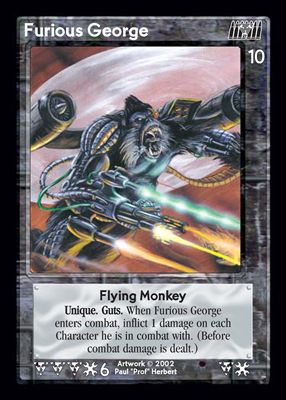 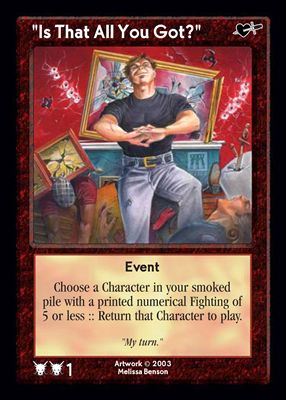 In this setting, geomancy is real. By controlling certain Feng Shui sites, one can control the fate of world. Various factions have sprung up to vie for this power in a struggle waged across the world throughout history and even across time in a conflict called "The Secret War". Another dimension called The Netherworld connects various time periods called "Junctures" such as the ancient past, the modern day, and the future. With these abilities, a faction that controls enough Feng Shui sites can change history in what is called a Critical Shift. That is why it's the Secret War; most people cannot tell that history or their own lives have changed, except for anyone who has traveled to the Netherworld as that makes them immune to being 'laterally reincarnated' in that way. Welcome, Secret Warrior. What future will you be fighting for? Object of Play You will play Feng Shui Sites to build your power, play characters to defend your sites, attack other player's sites or play other cards to support your goals. When one player has played, stolen or destroyed five Feng Shui Sites, they have win the game, but there's a catch. The last site cannot simply be played: you must take it from an opponent. Feng Shui Sites 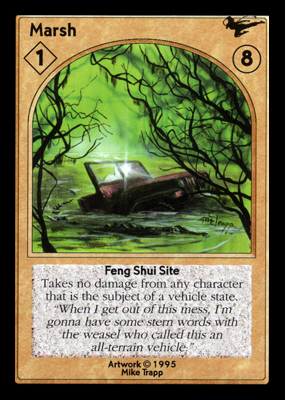 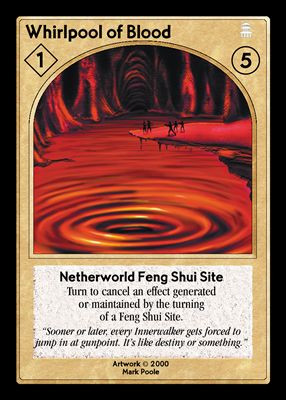 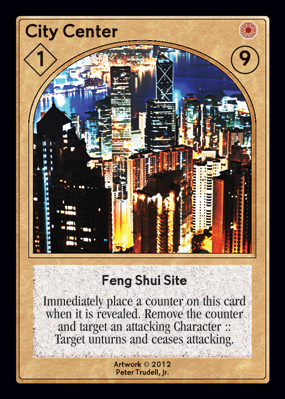 The core inclusion in a deck are Feng Shui Sites, sometimes called FSS's for short. These sites are part of how you win, but more importantly they provide one power automatically at the start of your turn. Power is a stored resource, so if you do not spend your power, you keep it for next turn. Feng Shui sites are played face down and do not get turned face up until some effect requires them to be revealed. Since they do not need to turn to generate power, they could instead turn for an effect. (Aren't you glad we used "turn" 3 different ways in that paragraph? To be clear, "To Turn" is "to rotate a card 90 degrees parallel to the play surface to indicate a card has been used" while "Turning Face Up or Face Down" is "to rotate a card along its longitudinal axis so the selected side of a card is now exposed from the play surface". Only FSS cards are ever face down. This is in addition to "A Turn" is "an individual play period for one player".) Once per turn a player can add a site to their Site Structure. Feng Shui Sites cost an amount of power equal to the number of Feng Shui Sites you already have in play, unless it is your first in which case it actually generates you one power on play. When played, the sites are arranged into columns, each column being one or two sites deep. These columns are called Locations. Locations are also where Characters are played. (More on them later.) When you play a new site, you can play it into a new location or an existing location behind the site already there. Resources Non-FSS cards have a different method to be played. They will have two costs: a power cost (which could be zero), and most cards also have a Resource Requirement, written in symbols. At the bottom of each card, on the left is the Resource Requirement and on the right is the Resource Provision. You must have Resource Provisions equal to or greater than the Resource Requirement of the card you wish to play, not counting itself. How do you get these resources? Well, provisions are usually obtained by playing Foundation card, usually a character. A Foundation card is any card that has no Resource Requirement but does contain a Resource Provision. These represent the faceless mooks or scientists that appear in early scenes of a movie. In order to play a card with a resource requirement, you must have that resource provision already amongst your Resource Pool. 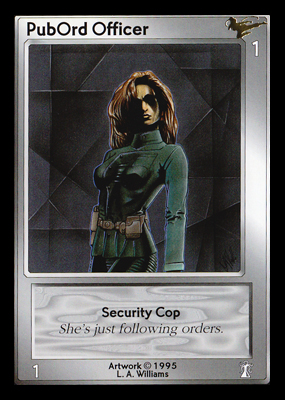  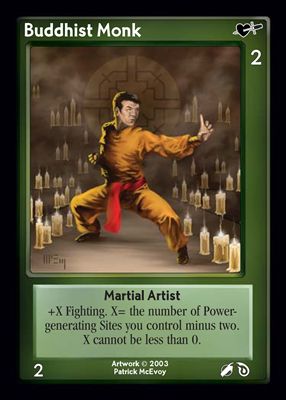 There are two primary things to know about these resources.
Other Card Types: Now that you know about power and resources, we can talk about the other card types: Characters: These are your primary method of attacking and defending. They represent people in your movie who can do things. They have a Fighting score, which indicates how much damage they can dish out and how much damage they can take before they're pushing daisies. 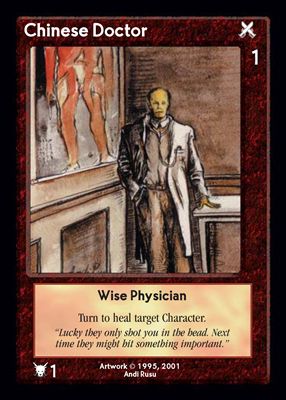 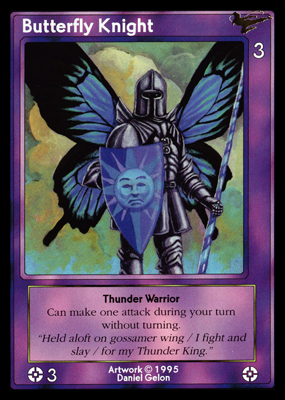 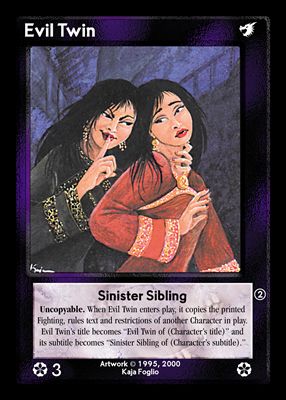 Event: This are a one-time occurrence that goes to the smoked pile after its effect is done. 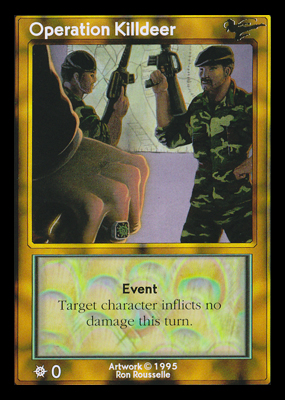 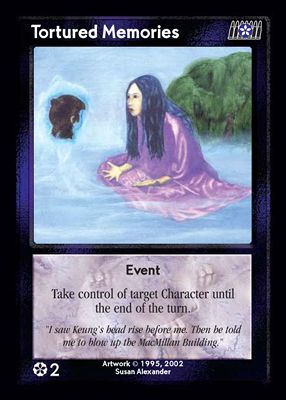  State: This is a card that attaches itself to another card in play. It may be a weapon, vehicle or something non physical.  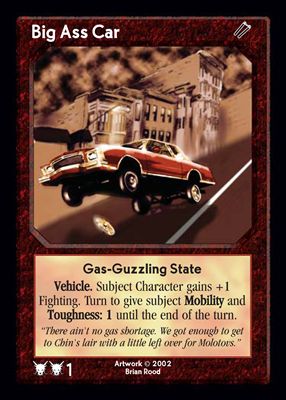 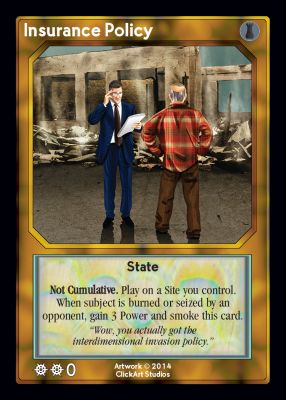 Edge: This is a card that stays in play but is not character or site. Usually these are more ephemeral concepts. 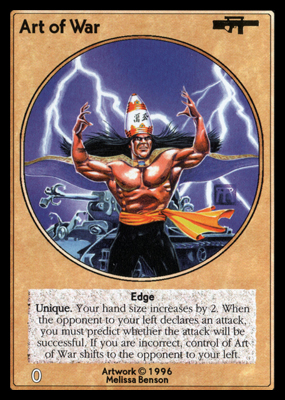 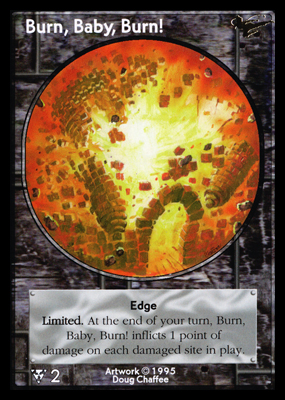 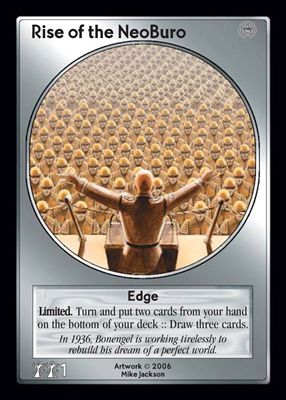 Site: Some sites are non-Feng Shui sites. They are played into your site structure, but otherwise behave like any other card: they are face up, they may cost power or have resource requirements, etc. Many are neutral, but many have faction or talent requirements. 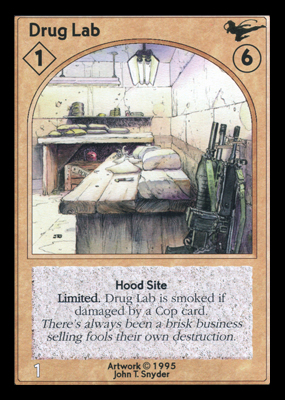 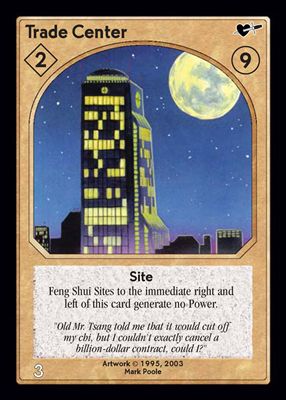 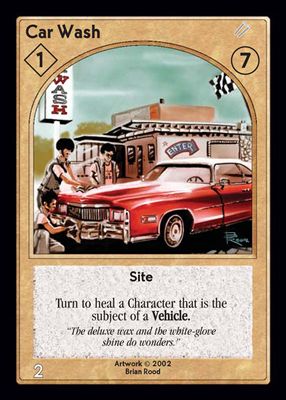 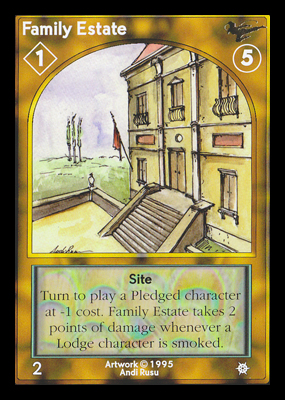 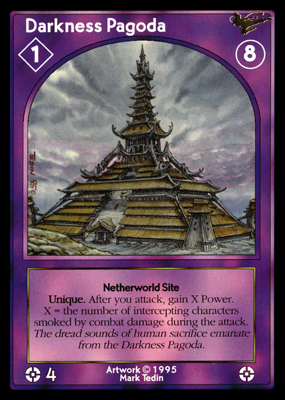 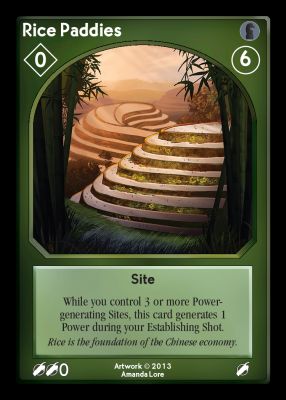 Attacking and Damage: To attack, it's essentially what you might expect: players select a set of their characters and choose a character or front-row site controlled by another player to attack. Characters at the location of the attacked card can defend, and characters at adjacent locations can turn to change location so that they can defend if they wish. There is another wrinkle: each other player besides the attacker and defender get to choose to join the attack or to join in the defense. This is the crux of the multiplayer in this game; if Alice is attacking Bob for the win, Charlie can turn his characters to intercept the attackers. This is why I think it shines at 3. In each combat, you have a single temporary ally that you are trying to help just enough to let you win without accidentally giving the game to them. Sites and Characters can take damage, usually from combat, but some other cards like Events can inflict damage as well. Damage is marked with tokens on cards and is not removed at the end of turn. Characters deal damage equal to their Fighting score, and any damage reduces a character's fighting, thereby also reducing its damage output. They inflict their full fighting each time they enter combat. So, if they have 4 fighting and get intercepted by a character with 1 fighting, they take one damage and are reduced to 3 fighting. If they they continue to be intercepted by a character with 1 fighting but Toughness: 2 (which prevents 2 damage), they still deal 3 damage, reduced to 1, and smoke the interceptor, and take 1 damage, reducing them to 2 fighting. On the other hand, sites simply have their Body reduced, and get turned face up if it were face down. If a card has a fighting or body of zero, it is destroyed or "Smoked". The one exception is when a Site has its body reduced to zero body as part of an attack. In that case, the attacking player may seize the site, healing it and adding it to their own site structure. If the site is a Feng Shui Site, the have the additional option to "burn" the site. They can burn it "for power" and take power equal to the number of players plus one (which ends their turn immediately), or they can burn it "for victory" and set it aside where it still counts for your victory condition. This represents that certain factions, specifically the Jammers, are fighting to destroy the Feng Shui Sites and put an end to the Secret War rather than attempt to use them for their own aims. Factions: These are the descriptions from the Shadowfist wikipedia page, and I am not going to pretend I can write better ones, so here they are: 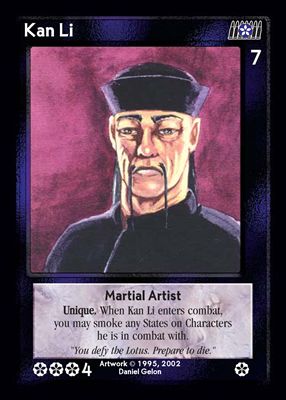 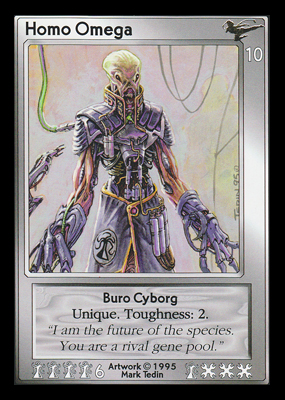  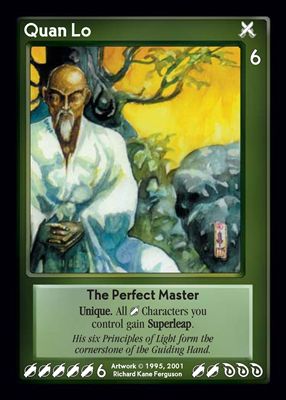 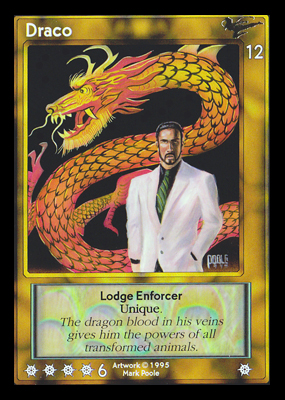
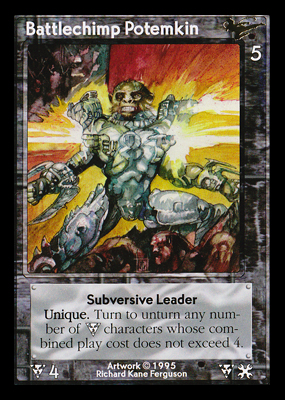 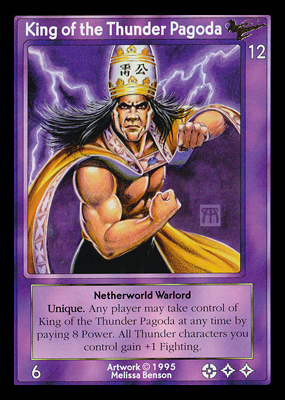
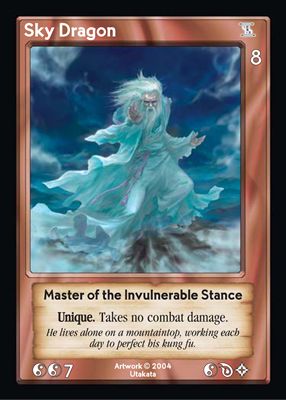 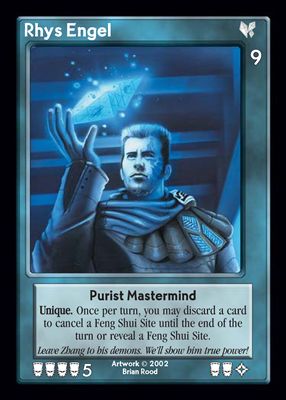 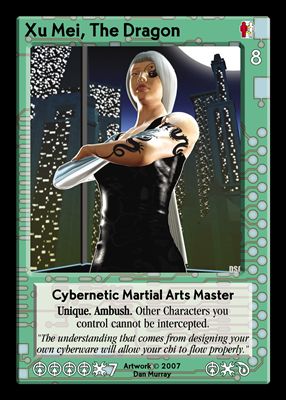
There are few restrictions for what is contained in your deck. The max of any one card is 5. Classically, decks contain: ⅕ Feng Shui Sites, ⅕ foundation cards, ⅕ 'hitter' characters, ⅕ utility cards / things to mess with your opponents and ⅕ zero cost cards / power generation (non-FSS) You can play cross-faction decks, but due to the way foundation characters work, it can be difficult to play cards that require more than one of each faction resource. For this reason, two factions can be tough to support and more than that is incredibly niche. Imagine requiring a two-card combo where each card needs 2 of a different faction resource. That means you need to play out 4 foundation characters, or at least 2 foundations and then two "bridge" characters to add the second resource. That can be a huge drag compared to someone who is playing one faction: once they play 2 foundations, the brakes have given out in their truck full of kickass on the way to your face. Other weird things I think are cool: You can make as many attacks as you like in a turn in whatever order you like, but if an attack fails to inflict damage on its target, you cannot make any further attacks that turn. So there is a pretty significant risk element for this, and makes spot removal and other interaction quite strong in stymieing attacks. There are two discard piles in Shadowfist. The Smoked Pile is used for anything that came into play: characters, sites, events, etc. This is named after the term 'smoked' which is what happens when something in play is destroyed. The Toasted Pile is used for any cards that were directly discarded without entering play, such as from your hand. Some cards will also toast themselves for balance purposes or will toast other cards just to be mean. The separation of these two piles means that in order to have your heavy hitter make a Golden Comeback, you have to have played it at least once already. (Obviously, you need to have appeared in the movie before now in order to appear later, right?) This acts as something of a regulator on recursion decks. At the start of each turn, you can discard a card before drawing to your hand size, usually six cards. If your hand really stinks, you can elect to skip power generation to discard any number of cards. This is usually harsh, but it's nice to have the option. Also, the very interesting thing is that this serves as the games 'mulligan'. If your opening hand has no FSS and no Foundation Characters, you can discard all the cards to try to find them, and you probably should. Limited! Limited means you can only have one card by that name under your control in play, but it's not Unique so each player is allowed to have one. That local restriction without having to get into Uniqueness auctions or anything is a great idea. Just don't forget what's Limited and accidentally play multiples out. Designators! Instead of an explicit sub-typing system, the game has a concept called "designators" which examine each word in a card's title and subtitle except type names. So, a card like Marmojet: Flying Monkey has those three words as designators. That means that card and Brass Monkey: Simian Automaton share a designator "Monkey" and are both equally work with a card like Mandrill Sergeant. The rules allow for plurals, possessives and even some compound words. It's a great way to allow for some interesting thematic cohesion and also allow certain broad punishment cards behave simply like Gambling House. Issues with the Gameplay: The game is not perfect. First off, the native vulnerabilities of wide site structures coupled with certain ubiquitous events that generate power mean that there is little reason to have more than two sites unless you are preparing to try to take your final site for victory. Also, the game has had trouble making foundations with greater than 1 cost playable. There are a few fringe instances you'd run in certain circumstances, but 90% of the time you just want the 1 cost that provides the right resources and/or talents. Both of these mean 40% of your deck is just "rocket" necessary to have a game and not the fun "payload" part of the missile, which is similar for many games of the time. Also, like most 90s card games, there are classic cards from the beginning that are oppressively powerful, and there is no ban list. History of the Game: As mentioned before, this game has gone through several publishers. It started with RPG company and original owners of Feng Shui Daedalus Entertainment until they went out of business in 1996. They were swept up in the original CCG boom like a lot of games. Z-Man games acquired the game's license in 2000. They printed ten products in their time, introduced preconstructed decks. Importantly, they messed around a little with the Hong Kong cinema theme, broadening into other movie and pop-cultural pastiches. The first was the set Boom Chaka Laka where a juncture opens into the world of the 1970s and Two-Fisted Tales of the Secret War based on 20s and 30s pulp magazines and noir films. Around 2005 Z-Man was ready to move on, but a group of fans formed Shadowfist Games to continue publishing while working with Zev until 2009. They continued the thematic exploration of westerns with Shurikens and Sixguns, and tried to make later sets draftable. In 2013, a new rightsholder, Inner Kingdom Games revived the game again, but brought about a lot of changes. The biggest was rebranding as a "Dynamic Card Game" with no randomized boosters, following along with the successful model shown by other companies at the time. They also attempted to streamline the game by reducing the game to just six factions, trimming the small factions added by later companies, but also removing the Architects. (If I recall correctly, they were going to also remove the Ascended but players wanted to keep them.) They also created the "Modern Format" which included only cards from IKG forward to allow new players a friendly entry point. They also directly changed some some oppressive cards and archetypes in modern only; cards with the same name but updated text, which was not unheard of in the history of this game. IKG's big changes were met with mixed popularity at first, but they had success overall. They released many products, more cards than any previous company except Z-Man, mostly via crowdfunding campaigns, and provided much-needed reprints of cards from short run sets like BCL and 2FT. Current State of the Game: After one of the IKG crowdfunding campaign failed to fund, in 2018 Vetusta Games acquired the rights to the game. This is where the story gets a little rocky again. They have not published anything since. Part of this surely is due to the pandemic, but also recently at time of writing, they have been releasing spoilers and they have the community concerned. The cards are bad, poorly formatted, and/or do not make sense from the perspective of someone who understands the game for reasons I don't really want to get into here. However, they appear receptive to this criticism from the old guard, so there may be hope yet. After all, if there's one thing that all Secret Warriors and Innerwalkers believe: it's that the future can still change. (late edit: lol Nope, VG has not listened to the old guard, is defensive of their bad ideas, and only created a huge kickstarter failure.) What if I want to play now? You should still be able to get the IKG era precons:
Resources: https://secretwarsociety.com/ This is the primary unofficial fan home of Shadowfist, mostly composed of a DB with all cards and images, and tournament info. It is this site that I am linking these images from, and the person who runs it kindly gave me permission to link to his images. https://shadowfist.com/ This is the official website for Vetusta Games's version of the game. Pretty bare bones right now, just serving existing products. https://en.wikipedia.org/wiki/Shadowfist The Wikipedia page for the game that I stole some stuff from. I've still barely scratched the surface of this game. It's a complicated game with a long history, and has a whole lot more content than most other games we're likely to talk about here, outside of V:TES. But I have to let this post go or it's going to threaten the character limit of a single post. Magnetic North fucked around with this message at 12:01 on Apr 17, 2023 |
|
|
|
Shadowfist was our 'break' CCG where we were tired of being competitive and worry about deckbuilding and just want to drop neutron bombs on eunuch sorcerers. Glad it's still hanging on, even if I wish it was doing better.
Dawgstar fucked around with this message at 04:19 on Aug 20, 2022 |
|
|
|
Holy crap. Thank you for that Shadowfist post. I had been looking forward to that. I've been out of town for over a week and not able to post much, but this was great to see. Now that I'm back to a normal schedule, I'm going to finish up a post about Magi Nation (from what I remember of it, at least).
|
|
|
|
Shadow fist seems to have exactly the same setting as the ttrpg Feng Shui? Except neither seem to directly reference each other. e: Oh, you mention that, sorry. DalaranJ fucked around with this message at 17:09 on Aug 24, 2022 |
|
|
|
DalaranJ posted:Shadow fist seems to have exactly the same setting as the ttrpg Feng Shui? Except neither seem to directly reference each other. If it helps the RPG doesn't talk about the card game much past its second edition. They mention some of the characters of course but it takes place post Operation Killdeer when I believe a lot of the Dragons were taken out.
|
|
|
|
I played Shadowrun back in the '90s at at a card store in Portland, ME. It was the big multiplayer game that we all played when we needed a break from MtG. I really loved the game and setting, so it's disappointing that it sounds like it's fallen on hard times. Back in the day, we bought the first two sets with no issue, but after that, the following sets were almost impossible to find. Shadowrun did have a bit of a kingmaker effect. Everyone would play feng shui sites until they needed one more to win. Someone would try to break through and steal their final site from another player, and the table would team up to prevent that from happening. Eventually the table would run out of ways to stop the next player and they'd win.
|
|
|
|
TesseractMinotaur posted:I played Shadowrun back in the '90s at at a card store in Portland, ME. It was the big multiplayer game that we all played when we needed a break from MtG. I really loved the game and setting, so it's disappointing that it sounds like it's fallen on hard times. Was that card store Cassablanca Comics, or Full Moon Games? The Portland area was my old stomping grounds back in the 90's.
|
|
|
|
Huh, Disney's making a TCG.
|
|
|
|
Yeah, people on a Flesh and Blood discord were talking about it this morning. I give it less than 2 years considering Ravensburger has no experience with ccgs AFAIK, and how their main markets are probably going to be stores like Walmart and Target, where the space for CCGs is already fairly tight.
|
|
|
|
Randalor posted:Yeah, people on a Flesh and Blood discord were talking about it this morning. I give it less than 2 years considering Ravensburger has no experience with ccgs AFAIK, and how their main markets are probably going to be stores like Walmart and Target, where the space for CCGs is already fairly tight. Yes, I thought Lightseekers had a shot, but it didn't. The Disney license might help. I'm excited to play Merfolk (Little Mermaid) and Cat Tribal (Lion King/Zootopia). Speaking of Lightseekers, it and Warhammer Champions were amazing, with a novel central gameplay mechanic, and worth an effort post... but I don't know when I'll have time.
|
|
|
|
Two years is always a good bet, as alluded to in this series of YouTube videos, which is worth a watch for any CCG-ers out there. Comments made in this new story seem to say that they are aiming to be less competitive (as in gameplay, not marketshare) than some of the very established games, like those in The Big Three. Have any CCG-style games survived long without a competitive scene or at least appealing to the competitive 'spikey' players? Outside of something literally cooperative like Arkham Horror or Marvel Champions.
|
|
|
|
Magnetic North posted:Two years is always a good bet, as alluded to in this series of YouTube videos, which is worth a watch for any CCG-ers out there. Decipher's Star Trek lasted for several years, but that was also from early on. Honestly, I'm kind of scratching my head at making it a CCG and not going with a living card game-lite model. I mean, they made Villainous, it's still getting new expansions 5 years later, and it's basically a LCG in a box. Maybe steal a page from Smash Up and Magic's Jumpstart and go with half-decks.
|
|
|
|
I don't know how long development processes take but I'd imagine it's a simple case of the gears having started turning a couple years ago looking at the 2020/21 TCG bubble due to shortages combined with demand spikes and a big dash crypto-style "investment" idiocy, and Disney wants a slice of that pie. Feels too late coming out of the gate, and who knows if Disney adults will have the buy-in that's being expected. Solid gameplay matters even if you don't take things seriously or competitively. Being collectable alone probably won't cut it.
|
|
|
|
Well, I hope this isn't dead quite yet (how are the other boxes treating you, Randalor) so I decided to delve into one of the other trainwreck CCGs. Ani-Mayhem! A CCG based on "all of anime". Or at least, all of anime as it was known in the West in 1996, which meant Ranma 1/2, Tenchi Muyo, Bubblegum Crisis and that ilk. There were actually several sets published, but I only ever saw the first set (called "set zero") before it died hard. Wikipedia summarises the core problem very subtly: Wikipedia posted:The result was a game that did not manage its terminology well. If you were to print out all the card errata, it would be at least three-to-four times as long as the game's rulebook. I honestly believed this game was made by some bunch of random people who managed to license a number of anime before they were well known, but no - it was officially made by the merchantising arm of Pioneer Animation. Why was I able to research this so easily? Because it turns out that Ani-Mayhem still has an active web site at http://ani-mayhem.com/. It was last updated in 2017 and its web design still looks like 1997, but it's there and works and has useful material on it, which is quite an achivement for a game that old. The rulebook was rewritten something like 3 times, but I'm going to be harsh and go by the rulebook that you'd have actually gotten if you bought this game back in 1996, which was the Set Zero rulebook. Ani-Mayhem Set Zero posted:1. Shuffle your Combat cards and set them face-down in a pile. ... Erk. We're already confused. We "shuffle our Power cards to start our Draw pile", but what about those extra Characters? Do they also get shuffled into the Draw pile, or is there a separate Draw pile for characters? If there are characters in our draw pile, what happens if we draw one of those in setup, and thus don't "draw 7 Power cards"? Do we discard it, keep drawing until we have 7 Power cards, or what..? Ani-Mayhem Set Zero posted:4. Choose 7 Items. Set them face down in a row in front of you. Now for the fun part. Ok, so that's the end of set up and the game's about to start, right? Ani-Mayhem Set Zero posted:5. You must have as many Disasters as the total number of the rest of the cards in your Draw pile. 1/3 of your Disasters must be Major Disasters. Shuffle and deal 2 Disasters face down over each item. Shuffle your remaining Disasters into your Draw pile. Err, what? The "fun bit" is dealing some more cards face down? Don't worry. I'm not going to go through the entire rulebook bit by bit. What we're ultimately being asked to do is to build 7 stacks of cards. Each stack consists of an Item card:  Two Disasters:   (Yes, that flavor text is exactly as it was printed on the card.) And a Location:  So, we have 7 of these stacks. You're probably starting to realise that what we actually have here is a rip-off of the Decipher Star Trek game. You know, that one that wasn't even recommended on this thread and that has a serious problem with lack of player int.. Ani-Mayhem Set Zero posted:Ani-Mayhem is the first collectible card game designed for solitaire play, since your real enemy is the Disasters. The basic object of the game, as in any scavenger hunt, is to collect a majority of Items (i.e. 4 out of 7) before the Disasters destroy themÖor you. Oh. I mean, there are rules included for playing with multiple players. Basically, all of the players make their own rows and they play as being connected together. There's also the "Big Board " variant in which all of the cards are put together in a grid instead of in rows, which in all of the later rulebooks became the default way to play. But none of it deals with the issue that you're going to build your deck to deal with your particular disasters and cards, and so it's always going to be beneficial to stick to what you've provided. The Big Board mode does make it harder to stick entirely to your own locations, but building a deck defensively is still going to be tough. Also, the game is semi-cooperative, in that if the Disasters manage to sieze a majority of items on the board, everyone loses, so you might need to buff the opponent on occasion. Also, why is Ifurita's key staff in the hideout of an unrelated space pirate and guarded by Dracula and a baby? How does that make any sense? Well, shut up. Why are you asking? Don't you get it? It's a super amazing wacky crossover! Isn't it great? It's so random and hilarious why aren't you laughing So, against this lot we have our starting party of 6 characters, including 80s anime classics like Pretty Sammy, Ranma, Priss Asagiri, and a farmer with a shotgun.  Those five icons are attack, defense, movement, charm, and energy. Having set up, we can now start our turn cycle. Step 1. Equip. You can play enhancement, equipment, and global power cards, and can also play extra characters. In a solitaire game, new characters can be played anywhere. In a 2 player game, they're brought in on the edge cards of the opponent's field. For some reason. To be given equipment, characters have to move "off the field" from one of the locations on your side - yet another reason to never visit opponent's locations. Here's an equipment card.  Step 2. Parlay. This is when you get to, um, talk to the other players about your moves, but also: Ani-Mayhem Set Zero posted:A Character may also call Parlay with any other Character able to move in 1 turn to the Location it is on. If the target accepts, each Character makes a demand to which the other must agree. If the target refuses, the parlayer can wage a Charm Battle: If the Charm (including Power & Item cards) of the Attacker is higher than that of the majority of Characters in the target's party (Charm's compared individually), the target must obey. If Combat is ordered, charmed Characters will fight until they take damage equal to twice the difference between their own Charm and that of their Charmer. Wwww... wait.. whaaaat!? So we can just take control of an opponent's characters as a standard part of our game? Or, wait, it doesn't say "opponent's". Can we charm our own characters? When does this action occur - in the Parlay phase before everything else, or does it set things up for the future phases? If, say, Pretty Sammy (charm 4) was to charm our Farmer With A Shotgun (charm 1) into fighting, does he get to fight until he takes 6 damage, rather than the 1 he'd normally take? Next, movement. Each character moves up to their movement in spaces. Characters can move in a group of up to 4. If characters are moving as a group, they move at the speed of the slowest character. Easy enough. Actually trying to claim the item on a stack is referred to as "scavenging". To scavenge, you need to have the skills listed on the location card. You then dig down through the Disaster stack, dealing with each Disaster as you get to it. If it's not a fight, like the Baby above, it just takes effect and then you move on. If it's a fight, like Dracula, all the characters in your party can fight it one by one. The "defense" score on a card is both its starting HP and its damage reduction. Oh, and you also get to play Combat Cards! That's these fellows:  You remember that we set them face-down in a pile at the start of the game. Well, at this point we get to pick 1 for ourselves - and also to pick one for the Disaster(!). Apparently encouraging padding a combat deck with weak cards? Still, it doesn't matter that much because nothing in the rulebook so far has actually told us to draw any combat cards, and indeed we never have. So are we just supposed to pick from the deck? Why bother setting it face-down then? You'll also notice that the combat card is reversable, with one side referring to charm and the other to regular combat. Thing is, nothing in the Charm Battle rules above said that you could pick a Combat card during a Charm Battle, and in fact it doesn't ever specify in the rules that you can, so I guess that's kind of useless. The text also mentions: Ani-Mayhem Set Zero posted:If Characters run away, their opponent gets a final, unanswered attack (after all, they are turning tail). Running Characters must leave a Location their next turn and can not perform any action (other than Reload and hope to avoid another Disaster). Of course, their opponent can move that next turn too. Some will chase you. Disasters don't run. ... Erm. Bear in mind that there's nothing saying that combat goes for multiple rounds, or how you would choose to run away. Does it mean "if you move away from a location"? Well, no, because you apparently have to leave the location next turn. You don't have to dig down the entire stack when scavenging - you can stop at any time - so why would you ever run away when facing the Disaster, then ending your Scavenge, has the same effect except that you do get to fight back? Oh, and that baby. It "attacks the nearest character". Which is the "nearest" character? If it's a party, do we pick? Does "attack" mean that it engages in combat? Presumably not, since it has no combat stats. If a Disaster that engages in combat wins, what happens depends on how badly the defender lost. If they lost all their health, they're "bonked", and out of play for 1 turn. If they lost all their health plus enough to kill them a second time, they're actually killed and discard. Either way, the Disaster loots all the items they were carrying. Equipment get dropped in the location, but actual items stay with the Disaster. If you remember, this is how you lose, since if Disasters claim a majority of the items all the players lose the game. If you defeat a Disaster that's holding items, it drops them at the bottom of the location stack it's in. If you manage to dig down to the bottom of a location's stack, you can take everything there. In a 2-player game, you can attack other characters in basically the same way. We don't know how that works between parties of characters because nothing ever tells us that. But you do get to loot all the opponent's items and equipment if you win. Next up: Ani-Mayhem Set Zero posted:Reload: Players take turns drawing cards from their Draw pile, each drawing 1 new card per turn until all players have 7 again. If any player draws a Disaster, Reloading stops immediately and players proceed to the Maintenance phase. .... If any player draws a Disaster, players proceed? I'm pretty sure that reads as "if anyone draws a Disaster, all players don't get any more draws this turn." Big, big ouch and big opportunity to troll opponents. Don't worry, though. There's much more confusion to come. Ani-Mayhem Set Zero posted:Disasters already on the Field move the number of Locations equal to their Movement. Disasters always move clockwise. Drawn Disasters enter at the far left of your Field. Disasters without Movement affect the closest group of Characters (again, based on a clockwise Movement). Minor Disasters with Movement scores move their number of cards equal to their Movement each turn until they complete 1 circuit of the Field and they are discarded. Major Disasters with Movement continue circling the Field, picking up 1 Item at every Location they land on until defeated. Ooo-kay. So, if we drew a Disaster we play it at the far left, and then Disasters that have movement (like Dracula) move clockwise. That's fair enough, but.. well, first of all, Disasters are typically face-down, so what's a "disaster on the field"? Do we turn them all face-up, or does this apply only to the disasters that we've turned face-up and failed to defeat? And wait, did that Baby just become an unstoppable force of nature? It's a non-combat Disaster, so there's no way to "defeat" it. It doesn't have movement, so it "affects the closest group of Characters based on a clockwise Movement". So are they saying it attacks a character every round and shuts it down for 2 turns? Or, heck, an entire group of characters? And Disasters pick up items.. what, just dropped items? Or any one under a stack? If they pick up items from the bottom of stacks, why try to Scavenge at all when a Disaster can take the item for you, and you can then just fight that one Disaster rather than having to fight two? Oh, wait, because you can't actually just decide to fight a Disaster, there's no action for that. But they can fight you (if they encounter one of your characters holding an item as they move) so maybe it's better to get one item on a combat strong character and just wait for stuff to be brought to them? Ani-Mayhem Set Zero posted:Start again. and whatever life brings you, try not to step in it. I already did, Ani-Mayhem, I already did. And that's all the actions available in the game. Oh, except for.. building a Haven. You can build a Haven if a party of 3 characters stays in a location for 2 turns. This isn't listed in the rules section of the book at all, but in the card reference. That's helpful. Oh, and by the way, there's no rules at all about deck size or card duplication other than that one above about needing to have a certain number of Disasters. That said, Items and Locations don't go in your draw pile, so technically it'd be legal to field an empty deck with no Draw pile at all - and therefore also no disasters. That said, with no duplication rules, you could just fill your deck up with, for example:   You have no combat disasters and no Bugrom, so you don't care, but you'll power up the opponent's Disasters. Oh, there's Flash cards as well. You play them and they have their effect. They're weird. Like, how about :  Ok, random sexist stereotype, and also, what does "work together" mean? For Scavenging you can say they can't combine skills for the Location, ok, but for Combat? That's always just one card against one other card. Yes, you can have a party fighting a Disaster, but they all do it individually. I think. As with everything else, the rules aren't clear. And then, there's the horror. The most infamous card in Ani-Mayhem, which turns the "what were they even thinking?" dial up to 11.  It makes your opponent skip 3 turns. It makes your opponent skip 3 turns. Well, it probably does. The sunburst icon means it's a "global", and the rules on globals state they "affect YOUR characters". And likewise, it's not clear what "3 uses" means. There's no rules on how a global can be "used" at all other than being played, and it's not clear how it would be used 3 times. But still. There are no card duplication rules You can have an entire Draw Deck of just this So, this goes in the lowest of the low pile with Arcadia in terms of dead CCGs that I've never even heard of being played, but apparently it did have some popularity at one point, perhaps just as anime trading cards? It did get an extra set, and a reboot as a Dragonball Z game, but it eventually dropped off the map and was replaced with the more successful VS system games. hyphz fucked around with this message at 20:59 on Sep 5, 2022 |
|
|
|
It's beautiful. I've looked at this for five hours now. El-Hazard, Project A-Ko, man. That takes me back. I should have figured that dorks were trying to make their multiversal fight games happen as soon as CCGs came out.
|
|
|
|
hyphz posted:Well, I hope this isn't dead quite yet (how are the other boxes treating you, Randalor) so I decided to delve into one of the other trainwreck CCGs. I haven't gotten around to cracking the other boxes yet, my table was taken up by a diamond painting I decided to start working on. They... kind of take awhile to finish.
|
|
|
|
Magnetic North posted:I should have figured that dorks were trying to make their multiversal fight games happen as soon as CCGs came out. Hey. Hey now. Listen: just because I still have reams of notes on an unplayable game idea from when I was fifteen that probably looks to an outsider like the scrawlings of a madman doesn't mean I'm a dork. Now, if you'll excuse me, I am going to go away now specifically not to cry. I'm not sure what I'm up to, but it definitely isn't wallowing in my lost youth and ambition.  Joking aside, Ani-Mayhem is the most unplayable poo poo I have ever seen, and I have seen some poo poo. I have played Spellfire. It's one thing for a game to be boring or solved or uncompetitive, but this is literally unplayable.
|
|
|
|
I don't know why, but the Farmer with a Shotgun having 1 charm rather that 0 is hilarious to me. "Somewhere, this man has a momma that loves him and he'll always be her cute baby boy."
|
|
|
|
After almost two months of schedule conflicts and COVID jumping in the way, my VTES group is playing again this Thursday. I am irrationally excited about this.
|
|
|
|
Railing Kill posted:After almost two months of schedule conflicts and COVID jumping in the way, my VTES group is playing again this Thursday. I am irrationally excited about this. Given that I haven't played in over 20 years and a zillion sets sets have been released since then, I'm wondering what the meta is like.
|
|
|
|
Gynovore posted:Given that I haven't played in over 20 years and a zillion sets sets have been released since then, I'm wondering what the meta is like. The meta is super healthy. Back in the day (late 90's through early 2000's) the entire meta revolved around Malkavian stealth bleed, and to a lesser extent Setite and Giovanni. Some beat/bleed decks or Brujah Princes would crack the meta from time to time, but largely it was either play OBF/DOM or OBF/PRE, or figure out how to not get eaten by the same. There was an overcorrection with 3E and the Sabbat sets that followed in the 2000's. There was a marked shift toward intercept and combat. Toolbox decks became more viable too. Decks packing the old stealth/bleed combat ends strikes started getting drummed off the table by the sheer amount of options made available to block. The meta for a while was attritional, sometimes in a good way and sometimes not. The pendulum swung back after that and it's stabilized in a pretty balanced place for a while. Basically, everyone needs to run some kind of combat or else you get you poo poo kicked in, but dedicated stealth decks can still get through most of the time. More and better intercept and resource management options have just made surviving a concerted stealth/bleed attack more viable than it was 20 years ago.
|
|
|
|
First look at some of the cards. https://www.polygon.com/23342656/mtg-lorcana-disney-tcg-ccg-first-cards-mickey-stitch-elsa-robinhood-maleficent
|
|
|
|
Apocron posted:First look at some of the cards. These look really good. Wasn't expecting original artwork. Also that stitch card rules.
|
|
|
|
Elblanco posted:These look really good. Wasn't expecting original artwork. Also that stitch card rules. I think Ravensburger has always used original art in the stuff related to Disney-owned property. I'm happy to see that trend continuing. It looks like there's a decent assortment of mechanics, and I'm actually genuinely looking forward to it now.
|
|
|
|
The art looks good but apparently one of the cards is convention exclusive. Hope it doesn't end up being too good?
|
|
|
|
Launching with an exclusive that I'll never get is a solid way to remind me I don't like this business model.
|
|
|
|
Sega 32X posted:The art looks good but apparently one of the cards is convention exclusive. Hope it doesn't end up being too good? quote:Update (Sept. 9): Representatives from Ravensburger clarified on Friday details about the availability of the Mickey Mouse Brave Little Tailor-themed card revealed on Thursday.
|
|
|
|
As far as I know, all "exclusive" stuff released at the D23 expos have always reached retail in some form. Then again, the only other "exclusive" thing I know of was Sorcerer Mickey for the old Disney Infinity games, and I think the only difference was that the D23 one had glow-in-the-dark stars on his hat.
|
|
|
|
Just noticed Dreamborn, Floodborn, Storyborn in addition to Villian and Hero. Some sort of strict typing in the game, perhaps? Also, what are the tiny colored icons beneath the title? I wonder if they will stray into unmixable attributes? Upper left appears to be cost. I bet the little diamonds are rarity; 'rockstar Stitch' being a rarer card than a basic Elsa, and Mickey has 4.
|
|
|
|
Iíve mentioned this one a few times so far, but I honestly thought it had sunk completely beneath the waves and I couldnít remember enough about it for a post. But it turns out there was some, small, vestiges left on the net of: So, the year is 1996. Somewhere in the Headquarters of White Wolf, important people are looking over at the royalty income from Vampire and the sales of Rage and thinking itís time for another card game based on a World of Darkness property. Mage would naturally lose out to Magic for the magic-y market and Vampire for urban fantasy. Wraith could hardly work as a card game based on eternal devotion, wistful feelings and the processes of coping with loss. And in 1996, they only had one other property. Changeling. And this is not the later Changeling: the Lost where youíre an actual changeling having escaped from the faerie realms and are trying to recover in the mortal world. No, this is the original Changeling: the Dreaming where youíre an actual half-fay and are pretty happy about it, and are desperately trying to keep the world dreamy and inspiring against the ravages of Banality. (At least in theory, in practice I recall the example of play said you were meant to go to back to the faerie realms and shoot arrows at each other.) It was generally considered practically unplayable, and largely a fake-aspirational gearpiece for renaissance fayre types and disassociated creativity-starved depressives I owned a copy. How do you make a CCG of that? Well, it turns out you.. send them back to the faerie realm to shoot arrows at each other, and maybe the odd monster. You also come up with a radical new distribution system which will transform and evolve the entire world of CCGs and herald a bright new era thatíll never be forgotten. We know how that went. It's probably worth mentioning that there already were collectable cards for Changeling RPG: the "bunk cards". They were art cards used to represent a part of the game's magic system, and were entirely optional, but were sold in booster backs on a collectable basis. I have no idea how they did. The idea of Arcadia is: itís an RPG encapsulated in a CCG. You make a character and have them moving around on a map doing Quests, while your opponent tries to do the same, and you both play monsters on each other. The unique distribution system was that the game would have no starter decks, only booster packs, in two different kinds: Character and Story. The game would be playable with just one of each booster, and the rules would be written on regular cards inserted in the boosters. I am grateful for this because it meant that the rules were in print almost too small to read, which means it has been transcribed online, and that transcription is the only copy of the rules Iím now aware of. In addition, card rarity is flat across the board. So although the types of card in each booster were controlled, any card from the pool could appear in any slot for the appropriate type. Character Generation So, to make our character we need to crack open a Character booster. Inside, weíll find a character card:  Yes, thatís what the cards looked like. They were printed on larger card and could be folded down into an actual character standee. This was probably the best part of the game. You can see that our character has three stats, represented by three icons: Might (the hammer), Resolve (the padlock), and Savvy (the wing). They arenít going to change. The main part of character generation is picking from the other cards in the booster - those White Wolf classics: Merits and Flaws!     Thereís a couple merits. they come in three kinds: abilities, advantages, allies, and arts. You get to play up to 5 points of them for free. You can then get more points by playing flaws.    Hereís the three types of flaw: enemies, weaknesses, and curses. The transcribed rulebook I have makes a serious error by referring to weaknesses as Waylays, which is actively confusing, because Waylays are a card type in the game but are used for something quite different. You might also notice that the card edges are squared. Thatís not just the scan - they were actually squared as printed. Once you have your merits and flaws, youíre done. You can make up a name and background, but it will never matter in play. Actually Playing To play, we need to crack open a Story booster. It contains three card types. Leagues, Waylays (actual proper waylays, not misprinted weaknesses), and quests. Quests are the really important ones; they define how youíre going to play. Unfortunately, theyíre double sided cards, and the few card collecting sites that still list Arcadia cards donít show the backs, which is awkward because they have the actual game mechanics on them. Which stymied me a lot, until I found the one (and probably only) Arcadia fan site on the web (https://arcadiaccg.wordpress.com/), and it had both sides of a quest card.  So, you can probably see the first problem here. We start with a fairly flavorful quest referring to interesting parts of the setting. And the Slave Pits and the Steam Drake are cards in the game. But you, and/or the opponent, might not have them. So the quest has to allow them to use any card you like to stand in for them, which just makes everything become kind of arbitrary. And thatís more or less the defining word for Arcadia, actually. Leagues are the cards that form the map. Each one shows a location on one side, and a set of rules for that location on the other. They have to be played map-side up because the rules require that features on the edges of the Leagues match up, but then they have to be constantly turned over in play in order to look at their rules. Wonderful bit of design? Yup.  However, one very cool thing about the Leagues that I didnít realise until I saw it on the fan site: if you have all the leagues in the entire card set, they actually do all fit together to form a coherent map of a region from the actual RPG.  I mean, youíll never use that map in the CCG, but itís kind of neat. Anyway. Each player takes turns placing leagues adjacent to existing ones, until both players have played 5. Next step: treasure. See that ďkeyĒ number on the Quest card? Thatís how many points of treasure we get to tuck under Leagues.  As youíll see, the treasure is technically a Merit. You can buy treasures as permanent abilities using Merit points, but you can also put them out to pick up during an adventure, up to a maximum of the treasure point limit on the Quest. Only you are allowed to pick up your own treasures, so in addition to constantly turning the League cards over, we now have to remember whose Treasure cards are whose. We pick our opponentís start position. They pick ours. After all that setup, turns are incredibly simple. Each turn is called a Day. You choose to either move one League in any direction, or to stay in the League youíre in. If you move, then you have to deal with the Leaving trial of the League youíre in, and the Entering trial of the one youíre entering, and then the opponent gets an opportunity to play a Waylay card on the league you arrive in. Hereís a Waylay:  The total number of points of Waylays your opponent gets to play in a game is specified on the Quest card. Other than that, though, they can play whichever ones they want from the set they have available. If you have been paying attention, you will have noticed that you have no deck in Arcadia - because there is no random drawing whatsoever! So, say that our Satyr, up top, is going into the Darkreach Mountains on the road. Itís free to enter by the Road. Then the opponent plays the Spidereye Goblin on us. The Spidereye Goblin has a list of terrains it can be encountered on, and Hills is one of them - and Darkreach Mountains has that icon, so itís a legal play. Per the rules on the card, we need to make a Might Trial of 5 to avoid being caught in a net. That means rolling at least a 5 on our Might + d6. So we need to bring our dice for this game. Our Might is 2. We roll a 3. Equal is enough, so we have avoided the net. Now we need to make an actual combat check against the Goblin, as indicated by the combat icon on the top of the card. Thatís our Might+d6, vs the Goblinís Combat+d6 (Waylays can have special Combat ratings). So itís a 50/50 roll off. We roll a 4, and the opponent rolls a 2. We win, and the Wayley gets discarded. Our turn is now over. On each Day, after moving (or not), we can encounter one thing on each League: the Waylay, the Treasure, or the Rest ability on the League. Since the opponent can only play Waylays when we move, this usually means needing to hang around in each League for an additional turn to benefit from being there. If we move onto an Opponentís league, we can Encounter them and make an opposed roll against them in any stat we like. If we lose a roll, we have to exhaust one of our Merit cards to no advantage - so they effectively act as hit points, although each Merit is only 1 HP. If we lost to a Waylay, it stays on the League, and we can try again next turn or leave - but only in the direction way came, which we also have to remember. If we leave a League with a Waylay and then move back again, the opponent gets to play an additional Waylay on us in addition to the one already there, so itís probably a bad idea to do that. If all your merits are exhausted, any further losses force you to discard a merit instead. If youíve discarded them, you instead get kicked back to your start position whenever you lose. Your opponent can exhaust your Flaws to bring them into play to hinder you, but once exhausted they no longer affect you and only unexhaust if the opponent uses a League which allows them to bring them back. Do your quest, and you win. Yay. If the opponent does theirs, you lose. Boo. And that's it. So there's nothing really bad about the rules. Some of the cards are a bit confusing - the rules aren't that well written, and there's things like whether or not the waylay you choose to be the one mentioned in the quest text counts against the point limit or not, but it's clear enough what they're going for. You notice there's experience points on the quest card, so if you want to, you can play a campaign and level up by adding the experience to your available points for merits, at the cost of adding half your experience to the Waylay limit for every quest. But of any CCG, the reaction to Arcadia isn't that it's obviously bad or obviously good or laughable or anything like that. It's kind of.. null. There's just.. no point. I mean, there's technically no point to any game, but it's doubly the case here. You move around to follow the instructions on your quest. Maybe there are some treasures which are good for you. You should probably go get them. You do get to know the opponent's quest, but before the game you have no idea what capabilities the opponent will have or which Waylays of theirs you'll be facing. I mean, since there's no decks you could technically just haul your entire collection to every game in order to play the most optimal Waylays against them on every occasion, and then it'd come down to, um, the roll of the dice. There's no delineated stages of play, there's very little build-up, direct player interaction is generally since it can't advance your quest. It's as empty as fey whimsy (or it would be if the actual mythical fae weren't a bunch of utter psychopaths and were just bloody terrifying). There's certainly no reason to play this as a CCG when you could play it as a board game or as an actual RPG for significantly less money overall. I have never seen or known Arcadia to be played. But it did get a single expansion pack, King Ironheart's Madness, which just contained more of the same, including a new area mapping by Leagues. There was supposed to be a second expansion too, but it never came out, even though it was scheduled for June 1997. Since the first set came out in August 1996, Arcadia lasted less than a year before disappearing into the weeds.
|
|
|
|

|
| # ? May 18, 2024 14:01 |
|
I love that the Changeling CCG is as pointless as the RPG. Mechanically, it seems more playable, but that's not saying much. I really dig new changeling (Lost) but old changeling was a dumpster fire. So VTES was washed out this week. We had one player come down with something and cancel. So we played Commander instead and made plans to play VTES again in two weeks.
|
|
|














